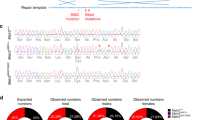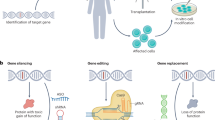Abstract
Amyotrophic lateral sclerosis (ALS) is an incurable degenerative disorder of motoneurons. We recently reported that reduced expression of Vegfa causes ALS-like motoneuron degeneration in Vegfaδ/δ mice. In a meta-analysis of over 900 individuals from Sweden and over 1,000 individuals from Belgium and England, we now report that subjects homozygous with respect to the haplotypes −2,578A/−1,154A/−634G or −2,578A/−1,154G/−634G in the VEGF promoter/leader sequence had a 1.8 times greater risk of ALS (P = 0.00004). These 'at-risk' haplotypes lowered circulating VEGF levels in vivo and reduced VEGF gene transcription, IRES-mediated VEGF expression and translation of a novel large-VEGF isoform (L-VEGF) in vivo. Moreover, SOD1G93A mice crossbred with Vegfaδ/δ mice died earlier due to more severe motoneuron degeneration. Vegfaδ/δ mice were unusually susceptible to persistent paralysis after spinal cord ischemia, and treatment with Vegfa protected mice against ischemic motoneuron death. These findings indicate that VEGF is a modifier of motoneuron degeneration in human ALS and unveil a therapeutic potential of Vegfa for stressed motoneurons in mice.
This is a preview of subscription content, access via your institution
Access options
Subscribe to this journal
Receive 12 print issues and online access
$209.00 per year
only $17.42 per issue
Buy this article
- Purchase on Springer Link
- Instant access to full article PDF
Prices may be subject to local taxes which are calculated during checkout


Similar content being viewed by others
References
Shaw, C.E., Al-Chalabi, A. & Leigh, N. Progress in the pathogenesis of amyotrophic lateral sclerosis. Curr. Neurol. Neurosci. Rep. 1, 69–76 (2001).
Brown, R.H. Jr. & Robberecht, W. Amyotrophic lateral sclerosis: pathogenesis. Semin. Neurol. 21, 131–139 (2001).
Rowland, L.P. & Shneider, N.A. Amyotrophic lateral sclerosis. N. Engl. J. Med. 344, 1688–1700 (2001).
Cleveland, D.W. & Rothstein, J.D. From Charcot to Lou Gehrig: deciphering selective motor neuron death in ALS. Nat. Rev. Neurosci. 2, 806–819 (2001).
Turner, M.R., Parton, M.J. & Leigh, P.N. Clinical trials in ALS: an overview. Semin. Neurol. 21, 167–175 (2001).
Siddique, T. & Lalani, I. Genetic aspects of amyotrophic lateral sclerosis. Adv. Neurol. 88, 21–32 (2002).
Andersen, P.M. Genetics of sporadic ALS. Amyotroph. Lateral. Scler. Other Motor Neuron Disord. 2 Suppl 1, S37–S41 (2001).
Hand, C.K. & Rouleau, G.A. Familial amyotrophic lateral sclerosis. Muscle Nerve 25, 135–159 (2002).
Yang, Y. et al. The gene encoding alsin, a protein with three guanine-nucleotide exchange factor domains, is mutated in a form of recessive amyotrophic lateral sclerosis. Nat. Genet. 29, 160–165 (2001).
Julien, J.P. Amyotrophic lateral sclerosis. unfolding the toxicity of the misfolded. Cell 104, 581–591 (2001).
Figlewicz, D.A. et al. Variants of the heavy neurofilament subunit are associated with the development of amyotrophic lateral sclerosis. Hum. Mol. Genet. 3, 1757–1761 (1994).
Al-Chalabi, A. et al. Deletions of the heavy neurofilament subunit tail in amyotrophic lateral sclerosis. Hum. Mol. Genet. 8, 157–164 (1999).
Panas, M. et al. Genotyping of presenilin-1 polymorphism in amyotrophic lateral sclerosis. J. Neurol. 247, 940–942 (2000).
Veldink, J.H. et al. Homozygous deletion of the survival motor neuron 2 gene is a prognostic factor in sporadic ALS. Neurology 56, 749–752 (2001).
Siddique, T. et al. Lack of association between apolipoprotein E genotype and sporadic amyotrophic lateral sclerosis. Neurogenetics 1, 213–216 (1998).
Lacomblez, L. et al. APOE: a potential marker of disease progression in ALS. Neurology 58, 1112–1114 (2002).
Oosthuyse, B. et al. Deletion of the hypoxia-response element in the vascular endothelial growth factor promoter causes motor neuron degeneration. Nat. Genet. 28, 131–138 (2001).
Skene, J.P. & Cleveland, D.W. Hypoxia and Lou Gehrig. Nat. Genet. 28, 107–108 (2001).
Shahbazi, M. et al. Vascular endothelial growth factor gene polymorphisms are associated with acute renal allograft rejection. J. Am. Soc. Nephrol. 13, 260–264 (2002).
Awata, T. et al. A common polymorphism in the 5′-untranslated region of the VEGF gene is associated with diabetic retinopathy in type 2 diabetes. Diabetes 51, 1635–1639 (2002).
Huez, I. et al. Two independent internal ribosome entry sites are involved in translation initiation of vascular endothelial growth factor mRNA. Mol. Cell. Biol. 18, 6178–6190 (1998).
Huez, I., Bornes, S., Bresson, D., Creancier, L. & Prats, H. New vascular endothelial growth factor isoform generated by internal ribosome entry site-driven CUG translation initiation. Mol. Endocrinol. 15, 2197–2210 (2001).
Mathews, D.H., Sabina, J., Zuker, M. & Turner, D.H. Expanded sequence dependence of thermodynamic parameters improves prediction of RNA secondary structure. J. Mol. Biol. 288, 911–940 (1999).
Altshuler, D. et al. The common PPARγ Pro12Ala polymorphism is associated with decreased risk of type 2 diabetes. Nat. Genet. 26, 76–80 (2000).
Gurney, M.E. The use of transgenic mouse models of amyotrophic lateral sclerosis in preclinical drug studies. J. Neurol. Sci. 152 Suppl 1, S67–S73 (1997).
Lang-Lazdunski, L. et al. Ischemic spinal cord injury induced by aortic cross-clamping: prevention by riluzole. Eur. J. Cardiothorac. Surg. 18, 174–181 (2000).
Lang-Lazdunski, L. et al. Spinal cord ischemia. Development of a model in the mouse. Stroke 31, 208–213 (2000).
McCarron, S.L. et al. Influence of cytokine gene polymorphisms on the development of prostate cancer. Cancer Res. 62, 3369–3372 (2002).
Hudder, A. & Werner, R. Analysis of a Charcot–Marie–Tooth disease mutation reveals an essential internal ribosome entry site element in the connexin-32 gene. J. Biol. Chem. 275, 34586–34591 (2000).
Lazaris-Karatzas, A., Montine, K.S. & Sonenberg, N. Malignant transformation by a eukaryotic initiation factor subunit that binds to mRNA 5′ cap. Nature 345, 544–547 (1990).
West, M.J., Sullivan, N.F. & Willis, A.E. Translational upregulation of the c-myc oncogene in Bloom's syndrome cell lines. Oncogene 11, 2515–2524 (1995).
Prats, A.C. & Prats, H. Translational control of gene expression: role of IRESs and consequences for cell transformation and angiogenesis. Prog. Nucleic Acid Res. Mol. Biol. 72, 367–413 (2002).
Ferrara, N. Role of vascular endothelial growth factor in regulation of physiological angiogenesis. Am J. Physiol. Cell Physiol. 280, C1358–C1366 (2001).
Ioannidis, J.P., Ntzani, E.E., Trikalinos, T.A. & Contopoulos-Ioannidis, D.G. Replication validity of genetic association studies. Nat. Genet. 29, 306–309 (2001).
Lohmueller, K.E., Pearce, C.L., Pike, M., Lander, E.S. & Hirschhorn, J.N. Meta-analysis of genetic association studies supports a contribution of common variants to susceptibility to common disease. Nat. Genet. 33, 177–182 (2003).
Landeghem, G.F., Tabatabaie, P., Beckman, L., Beckman, G. & Andersen, P.M. Mn-SOD signal sequence mutation associated with sporadic motor neuron disease. Eur. J. Neurol. 6, 639–644 (1999).
Giess, R. et al. Early onset of severe familial amyotrophic lateral sclerosis with a SOD- 1 mutation: potential impact of CNTF as a candidate modifier gene. Am. J. Hum. Genet. 70, 1277–1286 (2002).
Giess, R. et al. Potential role of LIF as a modifier gene in the pathogenesis of amyotrophic lateral sclerosis. Neurology 54, 1003–1005 (2000).
Yang, Z.J. et al. Role of vascular endothelial growth factor in neuronal DNA damage and repair in rat brain following a transient cerebral ischemia. J. Neurosci. Res. 70, 140–149 (2002).
Svensson, B. et al. Vascular endothelial growth factor protects cultured rat hippocampal neurons against hypoxic injury via an antiexcitotoxic, caspase-independent mechanism. J. Cereb. Blood Flow Metab. 22, 1170–1175 (2002).
Wick, A. et al. Neuroprotection by hypoxic preconditioning requires sequential activation of vascular endothelial growth factor receptor and Akt. J. Neurosci. 22, 6401–6407 (2002).
Facchiano, F. et al. Promotion of regeneration of corticospinal tract axons in rats with recombinant vascular endothelial growth factor alone and combined with adenovirus coding for this factor. J Neurosurg. 97, 161–168 (2002).
Matsuzaki, H. et al. Vascular endothelial growth factor rescues hippocampal neurons from glutamate-induced toxicity: signal transduction cascades. FASEB J. 15, 1218–1220 (2001).
Jin, K. et al. Vascular endothelial growth factor (VEGF) stimulates neurogenesis in vitro and in vivo. Proc. Natl. Acad. Sci. USA 99, 11946–11950 (2002).
Carmeliet, P. & Storkebaum, E. Vascular and neuronal effects of VEGF in the nervous system: implications for neurological disorders. Semin. Cell Dev. Biol. 13, 39–53 (2002).
Sondell, M., Sundler, F. & Kanje, M. Vascular endothelial growth factor is a neurotrophic factor which stimulates axonal outgrowth through the flk-1 receptor. Eur. J. Neurosci. 12, 4243–4254 (2000).
Li, B., Xu, W., Luo, C., Gozal, D. & Liu, R. VEGF-induced activation of the PI3-K/Akt pathway reduces mutant SOD1-mediated motor neuron cell death. Brain Res. Mol. Brain Res. 111, 155–164 (2003).
Nilsson, L.G. et al. The betula prospective cohort study: memory, health and aging. Aging Neuropsychol. Cogn. 4, 1–32 (1996).
Thijs, V., Peeters, E., Theys, P., Matthijs, G. & Robberecht, W. Demographic characteristics and prognosis in a Flemish amyotrophic lateral sclerosis population. Acta Neurol. Belg. 100, 84–90 (2000).
Terwilliger, J.D. & Ott, J. Handbook for Human Genetic Linkage (Johns Hopkins University Press, Baltimore, 1994).
Acknowledgements
The authors thank A. Claeys and B. VanKeirsbilck for technical support, G. Breier for plasmids, the VIB Genetic Service Facility for pyrosequencing, B. Dermaut and C. van Duijn for critical discussions of the statistical analyses and K. Brepoels, A. Bouché, M. Demol, E. Gils, B. Hermans, S. Janssen, W. Man, A. Manderveld, K. Maris, W. Martens, C. Nijs, M. Nijs, S. Meynen, P. Van Wesemael, A. Van den Hoeck, B. Vanwetswinkel and S. Wyns for assistance. D.L. is supported by the Flemish Institute for the promotion of scientific research and E.S. by the Fund for Scientific Research, Belgium. This work is supported by grants from the Fund for Scientific Research, the Concerted Research Actions, Belgium and the European Union to P.C.; from the Scientific Projects Committee University of Birmingham to K.M.; from the Fund for Scientific Research and the Interuniversity Attraction Pole program to C.V.B. and W.R.; from Saitama Medical School Research Center and Maruki Memorial Special Scholarship to T.A.; and from the Nutrition and Toxicology and Growth and Development Research Institutes in Maastricht to R.V.
Author information
Authors and Affiliations
Corresponding author
Ethics declarations
Competing interests
The authors declare no competing financial interests.
Supplementary information
Rights and permissions
About this article
Cite this article
Lambrechts, D., Storkebaum, E., Morimoto, M. et al. VEGF is a modifier of amyotrophic lateral sclerosis in mice and humans and protects motoneurons against ischemic death. Nat Genet 34, 383–394 (2003). https://doi.org/10.1038/ng1211
Received:
Accepted:
Published:
Issue Date:
DOI: https://doi.org/10.1038/ng1211



